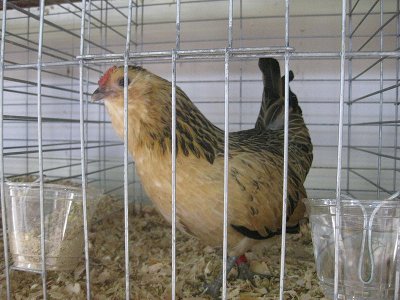Belgian Bearded d'Anvers
Category: Bantam Chickens

The Belgain Bearded d"anvers is a class of bantam chicken that is native to Belgium. It is an exact bantam, and has no full-sized complement. This chicken is one of the oldest bantam breed of chicken, and is considered to have derived in the Antwerp Province in northern Flanders. It is the solitary Belgian bantam chicken breed not threatened with death. The Belgain Bearded d"anvers is called as the Antwerp Belgian in the United States.
The Belgain Bearded d"anvers is a very small bird with a big, round breast that protrudes forward, and a curving tail. Usually, males are heavier than the female ones, with the maximum body weight of 700 grams (0.7 kg), whereas the females weigh 600 grams (0.6 kg). As the name suggests, it boasts a plentiful beard made of feathers that wraps the earlobes. It has a petite rose comb and tiny or missing wattles.
The Belgain Bearded d"anvers chicken is true bantam, and there is no standard dimension of the breed. These breeds come in 15 different body colors. This Belgain Bearded d"anvers chicken breed is an extremely active breed and it will perform well at shows. Even though the breed is still recognized in England and Germany as Antwerp, Belgians in America call these breeds as simply d’Anvers. The name “anver†is a division in Belgian that claims the source of this chicken bantam breed.
The Belgain Bearded d"anvers has an extremely amicable temperament, and bears captivity well. Hens of this breed lay petite creamy white color eggs and they usually weigh less than 35 grams. Furthermore, these hens are good sitters and good mothers.
The Belgain Bearded d"anvers has a tail-less variant, known as the Barbu de Grubbe, and is the precursor of other Belgian bantam chicken breeds, like the Barbu d'Everberg and the Barbu d'Uccle. The correct point of origin for this breed is mysterious, but it is probable that the breed has subsisted since at least the seventeenth century. It is most likely a successor of one among the vague basket bantams of the Pacific and Oceania, gathered by the Dutch.
Sample skins of the antique Moa Pakeke of Marquesas, Easter Island and the Koro Sea are identical to the d'Anvers. The early twentieth century experienced a substantial surge in interest by chicken breeders, and this breed was exported to the United States and other worldwide countries during the early part of that century. The Belgain Bearded d"anvers was first acknowledged into the Standard of Perfection of the Poultry Association of America during 1949, and it is categorized as a rose-comb, spotless-legged bantam.
The Belgain Bearded d"anvers is an entirely decorative breed, and most people keep the breed either as their pet or they are maintained by poultry fanciers for presentation. The hens of this breed are sociable to humans, but the roosters, which are the male breeds, may be aggressive. Most of these breeds are healthier and live longer if they are kept free-ranging or in an open area without crowding. This is a dual purpose Bantam breed that is developed for both egg laying and meat manufacture.
Though the lifespan of the Belgain Bearded d"anvers bantam chicken is not known, it has a shorter lifespan.

 Back To Category Bantam Chickens
Back To Category Bantam Chickens